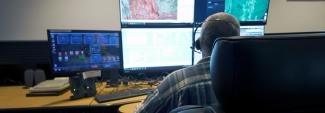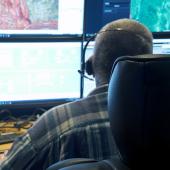The four phases of emergency management all benefit from FirstNet’s advanced communication capabilities. FirstNet has an important role in the phases of preparedness, response, and recovery. FirstNet is equally critical in the mitigation phase of emergency management.
New tools for mitigation
The mitigation phase of emergency management includes all the steps we take to minimize the impact of disasters. In the past, disaster mitigation might have stopped after digging a bigger culvert or moving critical infrastructure outside a flood zone. Today mitigation encompasses more.
Smart cities and remote sensors are two ways that technology is advancing mitigation efforts and disaster management. FirstNet provides the prioritized and secure connectivity that public safety needs for these technologies.
Sensors and disaster detection
The Internet of Things helps emergency managers to always have eyes on developing situations. That’s because the Internet of Things is an ever-growing network of objects with sensors and software that share data with each other and with emergency managers.
Smart cities use data collected from the Internet of Things to improve their operations. For example, a smart city traffic management system can make a city safer in many ways, including by preventing accidents using communication between vehicles, pedestrians’ smart phones, and the traffic control system. These safety benefits require a reliable broadband connection that FirstNet provides.
Sensors are especially helpful in mitigation, including flood gauges, air quality monitors and structure monitoring sensors. More than half of bridges in the U.S. are older than 50 years, so structure monitoring sensors are a vital mitigation strategy for protecting lives and property. These sensors measure cracks and tilts and issue alerts when necessary. FirstNet can provide the prioritized connectivity for these sensors.
Climate change
Extreme heat, drought, flooding, and wildfires are often exacerbated by climate change. As emergency managers incorporate climate change into risk management plans, technology will play a big part in mitigation efforts.
For example, FirstNet-enabled sensors can help in wildfire mitigation. These sensors can be added to existing infrastructure like transformers to create an always-on monitoring canopy. Time is of the essence when it comes to wildfire mitigation. When sensors report wildfire conditions from the field, emergency managers can foresee emerging issues before they result in a wildfire.
Cities can also use sensor technology to mitigate other effects of climate change by monitoring risks for hazards like air pollution and flooding.
Benefits and challenges
Remote sensing improves situational awareness and gives advance warning so that emergency managers can make better-informed and more timely decisions.
One of the limits of sensors can be the requirement of connectivity. Coverage, especially for rural and remote areas, is a priority in the FirstNet Authority’s contract with AT&T to build, deploy, and maintain the FirstNet network. As of February, AT&T has said FirstNet covers 2.81 million square miles nationwide, reaching more first responders than any network in the country. Over 95% of the initial nationwide buildout for FirstNet has been completed.
As part of FirstNet’s buildout plans, we worked with public safety leaders in all 50 states, five territories, and the District of Columbia to identify areas of coverage. The result? Coverage and capacity are expanding with dedicated public safety spectrum added to existing sites and new sites in strategic locations prioritized by local public safety officials.
Looking ahead, the advent of 5G is bringing new capabilities for public safety communications. 5G will bring faster data speeds, higher throughput capability, and improved latency – providing connectivity for the trillion of sensors expected to power the Internet of Things. With more 5G-enabled sensors available for emergency management, the data they provide will become even more useful for predicting risks and reducing the impact of disasters.
In April 2021, the FirstNet Authority Board directed investments to upgrade FirstNet to enable initial access to 5G for FirstNet. Now subscribers have access to AT&T’s 5G spectrum in 20 cities and 5G+ (mmWave) spectrum in parts of 44 cities and more than 30 venues. AT&T continues to deploy additional 5G spectrum across the country.
FirstNet and the emergency management cycle
To learn more about how FirstNet plays an important role in each phase of the emergency management cycle, check out my quarterly emergency management newsletters about preparedness, response, and recovery. And sign up for the newsletter to get the next edition in your inbox.




















